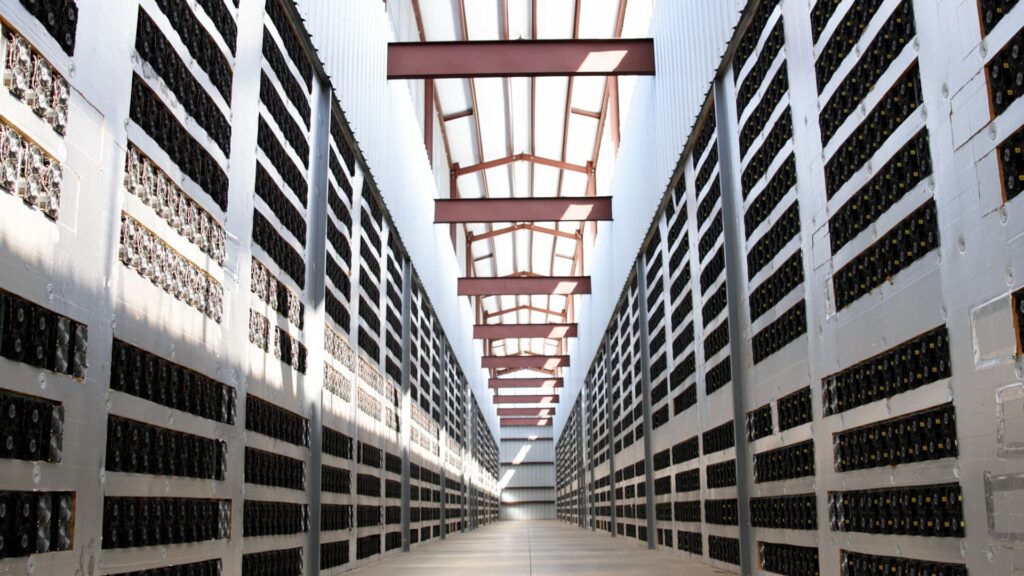[ad_1]
Now that bitcoin has pushed above its key resistance level of the year, the pressure is on for mining stocks, some of which could be in trouble if the cryptocurrency doesn’t reach $50,000 by the second quarter of 2024. Earlier this week bitcoin climbed as high as $35,000 at one point, after being stuck under $30,000 for several months. But the Bitcoin halving is expected in the spring and it will likely reduce companies’ revenue. That means the cryptocurrency may need to rally another 60% by then to lessen the suffering of some high-cost miners. “Bitcoin prices holding steady at ($28,000-$32,000) is not tenable for a number of crypto companies, and especially not for high-cost miners,” Needham’s John Todaro said in a note this week. “We anticipate material stock upside for Coinbase and low-cost miners if bitcoin prices surpass $45,000-$50,000 by the anticipated halving date of April 15, 2024, and material weakness if prices cannot sustain $45,000+ post-halving, in particular for high-cost miners.” “Post halving, lower-cost miners will take market share while higher cost producers will need to cut hash power contributed to the network until bitcoin prices rise,” he added. Bitcoin’s price is currently sitting just below $34,000, and chart analysts expect higher lows as well as higher highs over the next few months, with some anticipating it reaches $40,000 by the end of 2023. The Bitcoin halving event is highly anticipated event by crypto investors because it historically has set the stage for new bull runs. It takes place every four years when the reward for mining bitcoin – which makes up a significant portion of mining companies’ revenue – is cut in half. That reduction is mandated by the Bitcoin code to reduce the supply of the cryptocurrency over time. “The bitcoin mining industry is at a crucible moment as management teams (and investors) weigh the prospects of a bitcoin ETF, which may catalyze a rally, against record hashrate increases and the looming block reward halving that threaten industry revenues and profitability,” JPMorgan analyst Reginald Smith said in an Oct. 11 note. “With that as a back drop, we think discipline and timing are paramount and favor operators that offer the best relative value in light of their existing hashrate, operational efficiency, power contracts, funded growth plans and liquidity.” Marathon Digital and Riot Platforms are the largest mining stocks by market cap. Marathon famously has the highest energy costs and lowest margins, while Riot has relatively low power costs but shares are expensive. CLSK YTD mountain Cleanspark shares year to date CleanSpark is the only mining stock in JPMorgan’s coverage universe with an overweight rating, though its price target implies a 12% decline from current levels. Needham highlighted Riot and Cipher as its favorites, noting that their diversified revenue exposure could make impact from the halving more muted. Lower revenue, higher costs Generally, the mining stocks benefit from bitcoin price increases because those translate into higher mining revenue for the company. Riot shares have risen more than 10% over the past week, while CleanSpark climbed 12%, Marathon added 17% and Cipher jumped 40%. But their performance is more complex than that. In addition to their revenue from block rewards about to be cut in half, miners are also facing a steady rise in the network hash rate – which measures how much computing power the Bitcoin network uses to process transactions and is a key indicator of the network’s health. The Bitcoin hash rate has been hitting new all-time highs consistently throughout the year, which is good for the health and security of Bitcoin but tends to hurt miners’ revenue. “There’s been more miners that have come to the market with hardware and more people are competing for these coins today than ever before, and that makes the economics for the entire industry challenging,” Smith said. When it comes to costs, the main one for miners is electricity. Some have a contract with a power producer where they buy a certain amount of power annually at a fixed price. Miners who buy power at spot prices stand to lose from any spike in power prices, often in the summer or winter. Another big cost: hardware. Some miners use older, less efficient mining equipment and may not be able to invest in newer equipment as they juggle other costs and variables. That could be challenging for companies as the halving approaches, but a big enough rally could help. “If bitcoin goes up or doubles between now and the halving, these machines that I think will be uneconomical at the having could still be economical, and so it really depends on what happens with the price of bitcoin,” Smith said. “Roughly 20% of the network is powered by machines that just won’t be economical to the next halving so those machines will have to come offline. Depending on who runs them and whether or not that entity has faster machines somewhere else, they may get forced out of the out of the market.” —CNBC’s Michael Bloom contributed reporting.
[ad_2]
Source link













